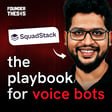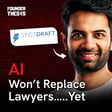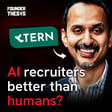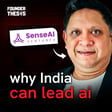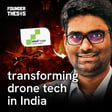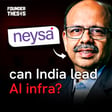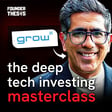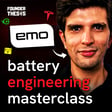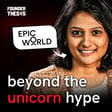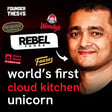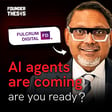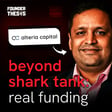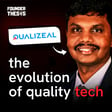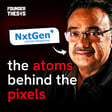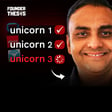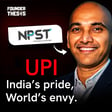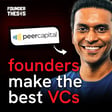Become a Creator today!Start creating today - Share your story with the world!
Start for free
00:00:00
00:00:01

Leveraging data for smart manufacturing | Jagadish Gattu @ UptimeAI
UptimeAI is a plug-and-play solution helping manufacturers solve glitches before they manifest by ingesting data generated from the production process. Jagadish talks about how he identified problems in traditional manufacturing and built the venture that’s powering smart manufacturing across the world.
Additional links:-
Transcript
Introduction to Faktime AI and Uptime AI
00:00:00
Speaker
Hey, everyone. I'm Jagdish Kattu. Also, go by Jag. I'm the founder and CEO of Faktime AI.
00:00:17
Speaker
Despite all the advances in robotics, the way manufacturing happens today still needs a lot of manpower. But the difference between good manufacturing and inefficient manufacturing is the ability to make use of data.
Manufacturing Challenges and Solutions with Uptime AI
00:00:29
Speaker
Uptime AI is a plug-and-play solution helping manufacturers to solve issues before they manifest by ingesting data generated from the entire production process.
00:00:38
Speaker
In this episode, your host Akshay Dutt talks with Jagdish Khatu, the founder of Uptime AI, about how he identified the problem with how traditional manufacturing works and built Uptime AI as a solution and what he built is today powering smarter manufacturing across the world. Stay tuned and subscribe to the Founder Thesis Podcast to learn from entrepreneurs who are identifying problems with traditional businesses and building globally accepted solutions.
Jagdish Kattu's Educational and Professional Journey
00:01:10
Speaker
So I completed my undergraduate from IIT Chennai. I did one year of chemical engineering and then I moved into mechanical engineering and I finished my major in mechanical engineering. Yeah. They do the campus interviews and I got a couple of offers, but I still wanted to explore a bit more. And so I applied for masters.
00:01:28
Speaker
back in the day from Michigan State, close to Detroit, automotive. Even from my undergrad, I took a fascination towards computers and programming and optimization, that kind of stuff. So did my thesis even in undergrad around the same optimization, modeling, simulation, that kind of stuff. And I continued that even in master's. It was mostly around a lot of programming, a lot of algorithms. So I graduated from Michigan State in 2005.
00:01:54
Speaker
And then I had a few offers in hand. So I ended up taking the opportunity at math books, which was also close to what I was doing, right? More modeling simulation, that kind of stuff, optimization. And it also gave me an opportunity to combine both my mechanical background and my mechanical roots along with a twist into computers and software and programming and that kind of stuff. So, so that's how I went to do math works. Yeah.
00:02:20
Speaker
What kind of software do they make, like simulating work? Basically, they make MATLAB, if you're familiar, which is essentially a mathematical programming language to do lots of programming, linear algebra, optimization, machine learning. At the same time, on the industrial side, they have a lot of solutions which can help you design control systems. A lot of the automotive companies, when you see all the software in the cars with
00:02:48
Speaker
auto transmission or braking systems or engine control, right? A lot of that is designed in MathWorks software. And then they're actually, that models are then generated into software, which are then embedded into the cars, right? Even in fighter jets, like F-22, F-16, right? A lot of the NASA and Boeing engines, right? A lot of that control side, it goes from some of the MathWorks tools. Okay.
00:03:14
Speaker
And what was your role there? MathWorks has a graduate engineering program, right? So they would hire a lot of master's students. And then that was an entry-level role. It was a role where you can kind of explore different teams, right? And so on one hand, I used to work with customers in terms of helping them use a MathWorks software solution. So that gave me focus and customer experience. On the other hand, 50% of other time
00:03:40
Speaker
We were free to pick up projects from different teams within the company, right? So I worked with software development, some consulting projects. So MathWorks has its own consulting division, right? And so I stayed in the role for about maybe year and a half or two, and I eventually decided to go into consulting. So I stayed in consulting for about maybe seven years or so at MathWorks.
00:04:03
Speaker
So, the projects you would be working on would be with industrial clients around designing of various kinds of systems. So, initially years, I did a lot of projects with automotive, right? I worked with companies like Ford, Toyota, Caterpillar, John Deere, Bobcat, a lot of these automotive companies, Daimler, and so on.
00:04:23
Speaker
And then I also worked with aerospace and defense companies, right? So I did projects with US Air Force, US Navy, NASA, Boeing, right? And then there was pharmaceuticals. And then there were medical devices. There were energy companies like Halliburton, marathon, Baker Hughes, and so on.
00:04:41
Speaker
All of them have to deal with either optimization, simulation of different systems, right? Understanding how they work, right? Trying to optimize them, identifying problems in them, right? And designing them. So even within those seven years, I kind of tried to start something during that time, but I also realized that there were some aspects, for example, more on the marketing, more on the sales side, that I felt that I needed to have a little bit more experience.
Digital Transformation and Industry 4.0
00:05:09
Speaker
After those seven, eight years, I then left MathWorks and then I wanted to do more on the commercial side. And so I did two things. One, I did my B-School, so I did my MBA. And then I also started my second half of my career, which is at GE, so General Electric. They are known for more around leadership training and leadership exposure, right?
00:05:34
Speaker
So I specifically took a lot of projects in the space of wherever there was possibly a new opportunity, I took those projects and led them all the way from ideation to market validation and then we picked a specific set of team, engineering team, and then also led the prototyping and then validation of the prototype.
00:05:54
Speaker
and then took it all the way until the point where we can actually either that was a viable product or if it was not viable, then we scrapped in the middle. So that was essentially that mini startup experience within the GE framework. This was also the time when GE was kind of going through their transformation about fail-fast and then digital innovation, industrial digitalization. So I was specifically brought in
00:06:17
Speaker
to bring that aspect of digital transformation more around bringing smarts into equipment, adding more analytics, more data processing and that kind of stuff, both at the edge and within the hardware as well as outside of the hardware. This was a time when Industry 4.0 was on the rage. Everybody wanted to do something and everybody was investing money. And so I got the opportunity to work with a lot of these large scale major clients. And that also gave me an understanding of what they were
00:06:45
Speaker
looking at what sort of problems they were trying to solve, why are those problems important, why they're not able to solve those problems with the current solutions, and so on. So, Industry 4.0 basically refers to IoT-enabled machineries.
Founding Uptime AI and Prototype Development
00:07:00
Speaker
Am I right with that?
00:07:01
Speaker
Yeah, so Industry 4.0 is essentially a couple of things, right? One, in terms of, yes, being able to measure and aggregate the data, right? And that involves if you don't have sensors, then you can actually bring in additional sensors and being able to capture that information, right? And then how do you utilize that information to add or to bring more value in terms of utilizing the data to bring intelligence and insight
00:07:30
Speaker
So tell me how the idea for Uptime was born. I guess it was in this tent specifically where you would have thought of becoming an entrepreneur. So tell me about that journey. I was looking at different opportunities or different ideas. So I had a bunch of different ideas and some of those ideas that I worked when I was doing my B-School as well.
00:07:49
Speaker
So we've kind of listed a few ideas. Some of them are blockchain related. Some of them are actually making a machine, which would like a consumer appliance, another one. So there were a bunch of different ideas. And then one of those ideas was also in the space of manufacturing, right? How can we
00:08:07
Speaker
improve the profitability of manufacturing, because I have a lot of context in that space, given my experience at GE and then my experience at MathWorks. And then from that, I was also working with my co-founder. And right now, he's my co-founder of onesie. So we will go almost 20, 25 years back. We know each other since our ninth grade. And he has already done a startup and he has exited that startup successfully. And he's also looking for doing something else. And that's when we were brainstorming a lot of different ideas. And we felt
00:08:36
Speaker
very strongly about the opportunity in the manufacturing space. Because if you think about manufacturing, right? Look, I mean, when the industrial revolution started and the mechanization started, right? That was a step up in terms of productivity, right? After that,
00:08:51
Speaker
You see there was the next step up when there was automation that was brought in, like with the digital controls and ELCs and so on. And then after that, we saw that the next step was with the IT. And this whole 90s were kind of the IT boom, with the SAPs and the ERPs and all that. And that provided a step up.
00:09:13
Speaker
After that, if you look at it, there is a lot of focus on data collection and the data aggregation. But then the actual next level of step up was there was a lull from almost 1990s to 2023 now, 2022 now, where
00:09:31
Speaker
what is the next big thing, right? And that's where we were looking at in terms of there is an opportunity there, it's right for disruption. And I also have the context that a lot of the tools in the market today, right? In terms of how the industry 4.0, they're all looking at how can you analyze the data, either aggregate the data or analyze or visualize the data, right? But those are all just the tools. It's almost like saying, I have a thermometer which can measure the temperature of the body. It is essentially analyzing a particular signal.
00:10:01
Speaker
But the actual value is in solving the problem. Just like if I compare a machine problem to a human issue, the actual value is reducing the fever. It's not detecting the fever, right? And so like for a human, you actually go to a doctor and the doctor then diagnosis and prescribes the medicine. And you go to a doctor who you know is actually good at diagnosing and can actually solve the problem. Similarly, in a machine with a manufacturing industry, when the machine has a problem,
00:10:30
Speaker
you actually go to a subject matter expert. These are people who have 30, 40 years of experience in the industry who can then look at the machine and then solve or diagnose the problem and solve the problem. Today in the manufacturing sector, the tools are more like thermometers. They can detect or they can provide a data analysis approach which can identify certain symptoms, but still you are dependent on these experts to really diagnose a problem.
00:10:57
Speaker
However, the difference is in the case of medical profession, medicine is a thriving industry, right? Whereas the experts in the manufacturing sector, manufacturing industry is losing their expertise at a large number because a lot of these people who have 30, 40 years of experience, they're all retiring. And if you notice back in 1980s, manufacturing
00:11:16
Speaker
and joining maybe out of steel or joining a manufacturing company was the best opportunities at that time. Today, the Googles and the Microsofts and the Facebooks, Amazons, people are going into software work. And the dynamic has also changed with the demographics and the expectations. People don't generally stay within the same plant or same role for 30 years. And so, on one hand, losing that expertise. On the other hand,
00:11:41
Speaker
people who are younger generation who are coming in, they don't generally prefer to necessarily work in harsh environments. And then even if they do, they're not staying for 30 years, 40 years. So, there's a natural gap. Operations are getting more complex. Machines are getting more older. So, how do you operate these
00:12:00
Speaker
plans more efficiently, profitably, without problems while you're having all these changes, including the whole change of energy mix and the sustainability initiative that is happening. And that was the premise. So that was essentially the basis on which primary air was started. So our primary air, the goal of the purpose of primary air
00:12:20
Speaker
is to really provide a solution that would mimic an expert in terms of learning and solving the problems for every machine in the world. And it's a software application that is going to guide the operators to solve either liability, equipment failure related issues, or sustainability in terms of reducing your energy consumption, improving your quality and improving your people productivity. Even with less experienced workforce,
00:12:46
Speaker
in a sustainable way, right? For us, that was a motivation behind starting a Prime AI. What kind of manufacturing were you targeting? So, I mean, for example, you have, say, a plant which makes iPhones, or you have a plant which makes cars, or you have, like, say, a paper mill. So, I mean, and they would all have very different kind of machinery set up, and say, a plant making electric car, like, say, Tesla plant might already
00:13:13
Speaker
have a lot of intelligence inbuilt into it. So, what was your target?
Technical Insights into Uptime AI's Functionality
00:13:18
Speaker
Yeah. So, we ultimately, the vision for Uptime AI is to become a virtual export platform for any machine, right? That could be a standalone machine like a card, right? Or that could be a manufacturing unit like a refinery or an electronic manufacturing, right?
00:13:36
Speaker
Now, what we have done, though, is we've essentially segmented the market into one, the standalone machines like cars and maybe cranes and other kinds of things. And then the second segment is discrete manufacturing, like the electronics and manufacturing or automobile manufacturing, which are more standalone blocks of systems or blocks of machines that do individual steps. And then we have the process industries, which are generally very continuous operations, meaning
00:14:06
Speaker
like refining or power generation, even chemicals, that kind of industries. And what we know is that in the process industries, they are generally run 24-7, 365 days. They are mostly fully automated, which means that there is no manual turning on, turning off. They run all the time. And if you have to run a plant 24-7, 365, completely automated,
00:14:31
Speaker
you need a minimum number of sensors, right? Otherwise you wouldn't be able to automate it. And so we knew that there will be sufficient number of sensors in the process industries to begin with, right? And so we started with a focus on the process industries because of that fact, right? Because
00:14:48
Speaker
there are sufficient number of sensors. So we wouldn't have to start from sensorization, right? So from that perspective, we started in process, right? So today we have deployments in oil and gas, like refining, we have deployments in chemicals, power, right? Both fossil gas waste, right? As well as we are deploying for renewables, right? So those are industries that we are covering right now. And we do know that as in different phases, we are going to expand into the other segments as well.
00:15:18
Speaker
Okay, so like tell me about the zero to one, like you had an idea and so from taking that idea to actually onboarding your first customers, you know, that journey of building the prototype and your go to market and getting your first customer in and did you need to raise funds before you could get your first customer in? Tell me that journey.
00:15:39
Speaker
Yeah, so see, I think there are two ways to go about the start of the journey. One, you pick up a space where you have context and knowledge, so that you have some time advantage. Or you pick up a space
00:15:54
Speaker
where you find an idea interesting, but then you spend maybe six months to one and a half years, two years, depending on the idea and the space, just learning the BS in that space. So for us, fortunately, I do have significant experience in the space. So from that perspective, as I mentioned, we are not looking at how to analyze the data, how to build a model. That part was
00:16:18
Speaker
anybody who's coming out of a graduate school these days, they can build a model. If you give them data, I mean, there are enough ways to build models, right? Our focus was essentially what happens after that, right? Which is how can I help the operations teams solve that problem?
00:16:35
Speaker
How do I make sure that these models stay up to date with the minimum amount of effort in terms of maintaining them? How do I make sure that the knowledge in terms of how you can solve the problems are growing? Eventually, we are looking at mimicking or essentially creating a virtual expert.
00:16:52
Speaker
Then we did two things. One, we started looking at what would be a prototype or MVP, so to speak. So we just took people, me and my co-founder once we started building up something in terms of as an MVP. At the same time, we onboarded one more person who would also support, who would join us as one of the core team members. And then at the same time, I was in India at the time because my co-founder was in India. And so we were building a team within India. So
00:17:20
Speaker
We essentially spent some time and we took that idea to a few customers within India. And we reached out, called reach out, or we tried to get through some of the connections, right? Networking. And eventually we had an opportunity to pitch for a couple of our customers, right? Within India.
00:17:37
Speaker
And that's when they said, yeah, I mean, no, we liked the idea of continuous learning, something that can actually learn continuously to get more smarter. That makes a lot of sense. And they really liked it. And it was essentially thought of and they were definitely one of the thought leaders in the industry. And they really.
00:17:54
Speaker
I took it for two liking and they gave us an opportunity to try it. I tested at one of their sites. That's how we started. And at the same time, once we had a couple of customers who were interested in idea in terms of know how, what they were doing.
00:18:09
Speaker
We then also play some friendship family around, right? We then raise money and then we build a team, right? And that's how we started the journey in terms of, okay, now we have a team, we have a customer, right? Who's interested. And then we essentially started iterating and then kind of going through that journey. Yeah.
00:18:25
Speaker
What was the time period? When did you raise funds? We started in late 2019 and perhaps we raised the funds towards the end of 2019, maybe after 3-4 months. And when did you on-board Tata Power? So we started working with Tata Power towards the same time, around the end of 2019 or 2020.
00:18:46
Speaker
So tell me what is, how does a power plant work and in what way would the uptime make it better? Like what is, first explain like the lay of the land, like what is a power plant, how does it work? And then if you can tell me what you came in and did to make it better.
00:19:02
Speaker
Yeah, so if you think about a power plant, you can have different sources in terms of energy. I'll talk about the fossil ones first. We can also talk about the wind, but the fossil ones are you can use either coal or you can use gas. Basically, what you are doing is you are burning the coal or burning the gas.
00:19:20
Speaker
And that would generate heat. And that heat can essentially be used to generate steam. You're using the steam to do work. And that steam would turn a turbine, which would essentially, in turn, turn a generator. And that generator would then generate electricity power. And whatever steam that is left out, that is coming out after it has already done the work,
00:19:42
Speaker
It is essentially being condensed back into water, right? And then it is again sent back to the boiler. And there are multiple steps to improve the efficiency of this operation. Now imagine that you have a problem in the boiler or you have a problem with the generator and the generator stops working, right? Now imagine you're generating maybe a hundred megawatts. Okay.
00:20:02
Speaker
And so in an hour, you're generating a hundred megawatt hours. It could be maybe 3,000 rupees or 4,000 rupees, right? So, a hundred of them is essentially in an hour, you could be losing, you know, a hundred, right? So that could be almost 20 lakhs. At the same time, let us say you are spending or you are consuming 2% extra coal.
00:20:24
Speaker
And again, think about the volume that you are doing, right? For six months, if you're consuming 2% extra coal, you're talking about tens or even hundreds of crores of rupees that you are losing because of the significant volume, right? Same thing you need to find it. And so what Uptime AI software does is, number one, first it detects where the problems could be happening.
00:20:46
Speaker
First thing is a software helps the operations teams identify the problems at its beginning stages. So that the damage is not done, first of all. How does it do that? What is the kind of data that is getting fed into it? Is it like temperature data? Like you would have thermal sensors and what else?
00:21:06
Speaker
So, Uptime AI is unique from the perspective of it looks at all the data from the plant, right? And that could be data like temperatures and temperature data, it could be pressure data, it could be flow data, it could be ambient temperature data, it could be humidity data, it could be cold quality, it could be water quality, right?
00:21:26
Speaker
It could essentially be your condenser vacuum, your heater temperatures, right? So it is looking at every single variable that is available in the plan for every single equipment. How would it get data about cold quality through like a camera and then using machine vision?
00:21:45
Speaker
So, some of those are manually measured and a lot of them are online measurements, right? So, specifically, for example, cold quality, it is measured by a lab, right? And there is a lab, they take samples on a daily basis, on a regular basis. And cold quality, it wouldn't change on a minute to minute because you have a... There'll be one lot. Exactly. Exactly.
00:22:07
Speaker
But other than the cold quality, everything else that we talked about, whether it is temperature pressures, vibration, or flow, or ambient temperature, these are all online measurements. They are measured using sensors. How is flow measured? Flow would tell you that water is going through this pipe at like 70 liters per minute. That's what it would do.
00:22:27
Speaker
Right. Exactly. And so what we are doing is we are taking those data into our application and the application first, it understands the relations between different parameters. Because as I said, in a plant, you can have up to maybe one unit may have in up to 5,000 census.
00:22:44
Speaker
So the application and the deep learning models that the application uses is really understanding the relations between all the different parameters that are relevant to those systems. And once it understands that, then that same models are then analyzing the real time data that is coming out to then assess whether there is a problem with a particular system or not. And then it is identifying that
00:23:13
Speaker
Hey, I mean, it looks like there could be a problem with your boiler or they could be a problem with your fan, right? Or they could be a problem, right? Or your heat exchanger. So it's not enough to say that your vibration is increasing or your pressure is increasing. The key is why is it right? Why is that happening?
00:23:30
Speaker
And that's where you are focusing on the next steps in terms of how to do that. So we have built-in libraries in terms of very modes and recommendations that the application, once it analyzes the data, it can look at the data and it can interpret that. The application can look at different things that are happening in the operations and then translate those into a specific diagnosis and the recommendations, right? Yeah, go ahead.
00:23:56
Speaker
Does this need you to have expertise in a power plant? Would that subject matter expertise play a role here? Or is it that through machine learning, the system automatically gets that expertise? The main thing in this industry is that it's a very biased data set, meaning you have a lot of data where machines are operating without any problems.
00:24:17
Speaker
in very little data about actual problems. And so, yes, ideally, if you have lots and lots of failures, you can basically use just pure data to learn about those failures, learn about the domain. But unfortunately, that is not the case. If you are having a power plant which is failing every other day, they wouldn't be in business, basically.
00:24:40
Speaker
Yeah. So that option, which could work in other industries, right? If you want to train what is a cat and what is a dog, right? You could probably use that approach, but that doesn't work in industrial settings. So that's where we do bring in a baseline of subject matter expertise, right? Essentially, our core focus is bringing in AI.
00:25:04
Speaker
and bringing in your domain expertise and essentially connecting them and making them one seamless application, right? Today, you have solutions which will help you analyze the data like a data scientist, right? And then you have operations teams who can analyze the operation site, right? But there is no connection between them because the data scientist doesn't understand what the operator is doing and the operator doesn't understand what the data science models are doing, right?
00:25:27
Speaker
Whereas what we are willing is we bring the application has built in understanding of what a motor means, what a turbine means, what a compressor means, what a distillation column means. And so application can understand how to interpret the information. So that is baked into the application to begin with. And then
00:25:44
Speaker
So you would have had to feed it to normal values like this is the normal value for temperature, this is the normal value for flow, this is the normal value for pressure and so that it can then flag that this is a deviation and then like probably an expert must have trained that this is what this deviation could mean, this is the linkage between this data and this data and like that like something like that is what you would have done.
00:26:10
Speaker
Yeah, so we don't believe in specifying a specific threshold for different systems because see that approach will never scale because as I mentioned a power plant with five units may have 25,000 sensors. Okay, if you start putting in this sensor should be between this value this I mean first of all you have to
00:26:29
Speaker
Well, maybe if not 25,000, even if you have to manage that for 5,000 census, it's a huge effort, right? And then you will have a pump, which is brand new and a pump, which is 25 years old and they wouldn't behave the same way, right? And so who is going to keep on changing these limits? You see what I'm saying? So, and this is one of the reasons why a lot of the solutions out there, they only cover maybe 5% of the data, right? They don't actually cover a hundred percent, right? Because it's not scalable.
00:26:57
Speaker
So what we do is we take an approach where we don't want to specify any of these kind of thresholds. We let the statistics and the math do that kind of job. Our application is like a doctor, which is already trained in terms of understanding what is a motor, what is a machine, and what is a turbine, and so on. And once you deploy, it is fine-tuning itself.
00:27:18
Speaker
to become very, very specific and precise for that particular type of machine and that particular type of operation. And that's how we are also building the knowledge base within the application, that the application continues to learn about how it can do better by both looking at and observing and learning from what is working, what is not working. Let's say a cooling water tower or a wet gas compressor. If the diagnosis,
00:27:45
Speaker
is actually successful. And if it is working, application learns that, hey, I mean, this is actually working, and this is what I need to do in the future. If it doesn't work, and if the operator says, no, this is not a problem, or this is not working, application learns that, hey, I mean, I shouldn't do this in the future. Exactly how a expert would become an expert from their experience. So you did marry human intelligence to this, right? How was that done? It's like a textbook. You have a textbook which has information about
00:28:15
Speaker
what to do when different types of problems appear. The difference between that and an expert is essentially they know which parts to look, which aspects of this diagnosis to really consider for that age. And they are now trying to mix multiple parameters. We are essentially taking that initial set of knowledge about what is a turbine, what is a compressor, but then for a specific set of fossil plant or a refinery or specific type of operation,
00:28:44
Speaker
the based on the user's experience and user's feedback, we are fine tuning it to make it much more precise. Okay. So yeah, tell me about this pilot Kritata power then like, so how did the, how did the machine get the data? Like, was it, is it possible to do an API integration here or like, how does that happen?
00:29:05
Speaker
Yeah. So many of these companies in manufacturing plants, they do generally aggregate the data,
Business Model and Market Expansion
00:29:11
Speaker
right? And it goes into a central control system. And from there you can tap in and you can use APIs to pull it up, right? And that's what we do. Yeah. So how did that pilot go? Like what was the kind of outcome that you showed to data power? You must have reached a proof of concept stage from an MVP stage. Tell me about that.
00:29:30
Speaker
Yeah, so they had a couple of specific use cases that they've given us and they were asking, can you do this, right? And essentially we have taken the data and we were able to show that, yes, I mean, we can solve these problems. And that's how they liked what we have done. And that's how we were able to expand it and we were able to deploy it across all their six units.
00:29:51
Speaker
How do you monetize? What is the kind of pricing plan for this? How is it priced? So Haas is a SaaS model, right? It's a subscription based model. And so it's based on annual subscription based on the industry and the amount of data or the sensors that we are processing. So tell me the journey from Tata Power onwards.
00:30:10
Speaker
We were also working with multiple clients at the time. We have deployments with VPCL refining and we have deployments with GMR. We are doing deployments with several other customers in the Middle East, as well as North America and so on. Each industry you enter would need you to build that textbook for it, right? Like the power plant, you build a knowledge base. So you would have had to do that for every new industry.
00:30:36
Speaker
Yeah. So we took industries which have a lot of commonality, right? And then there are certain aspects which are slightly different, right? But those are not major aspects, right? So if you look at a pump or a motor or a fan, motor is a motor in pretty much any industry, right? So there are a lot of commonality, but of course there are some special equipment which are
00:30:57
Speaker
only specific to certain industries. And we have essentially also focused on developing those aspects as we target specific industries. The ROI for a customer would be like maybe you could do predictions that this particular machine needs to be looked into or it could be about if there is a deviation from normal, then what is the root cause of that so that it is quickly fixed. Like those are the kind of
00:31:25
Speaker
So, so think about it, right? We have had cases where, for example, there is a, there's a bearing vibration on it, on an equipment. Typically you can start looking at the bearings, whether there's a problem with the bearings or not in the bearings, right? Or maybe the lubrication is not happening, right? And you do all of these and then you don't find anything wrong with the bearings.
00:31:45
Speaker
Okay. And then we start looking at something else, right? Then you bring maybe an expert or a consultant from outside, right? Or internally, right? And then they start digging into the data and then they start analyzing all these issues. And it's not, it's very common that these kinds of problems can take, they typically, customers typically create projects, maybe put two engineers and one expert, and they can almost take a quarter to identify what is a problem, right?
00:32:10
Speaker
And imagine that within that quarter, if you're consuming one ton of steam extra, let us say, that one ton of steam could have costed you almost 75 lakhs. And whereas if you are using a solution and if our solution can point you to that problem, saying that it's not actually the bearing, it could be a seed leakage or it could be something else. And if we can point out that problem within a week,
00:32:36
Speaker
And that allows you to not only save the excess steam consumption, but you can also plan the maintenance better, potentially even prevent any accidents, improve your energy costs and sustainability.
00:32:51
Speaker
And you also give better productivity for people and better satisfaction because if you ask any planned operations teams, right? Or do they not like, they don't want to come into work and hear that there's a problem and they don't want to be surprised, right? Because keep in mind, these are also places where people can get hurt. If there is an accident in your turbine, there can be parts which will fly like 500 meters.
00:33:17
Speaker
I don't know if you've seen a steam turbine in a power plant. It might be almost as big as a two-storted building. So these are essentially gigantic machines, right? These are not small machines. So in the ROI, as I mentioned, it could be the fact that we prevented the bearing from getting completely deteriorated, right? We have prevented the energy loss. We have also improved the productivity. And as we do this well, you also don't have to store significant amount of space.
00:33:47
Speaker
Keep in mind the turbine can be several tens of or even up to a hundred crores. They are very expensive equipment. People don't generally keep the space for large equipment as a duplicate, as a separate equipment because it's very expensive. But even if you're keeping components, they could essentially be 50 lakhs.
00:34:08
Speaker
And if you are storing several of those, your inventory costs are going to go pretty high, right? And so the ROI is essentially making sure that your plant productivity, right? You're not losing production, right? You're keeping the plant running more. It could essentially mean you are reducing your energy consumption. You're improving your efficiency.
00:34:29
Speaker
And you're also improving your people productivity and the satisfaction of those. And more intangibles are about how you are managing the knowledge because what you're doing here on one pump in one unit, the application is able to learn what is working, what is not working. And it can actually bring that same best practices to a side, which is actually on the other side of the country within minutes and without you doing anything else. And those are more intangible in terms of how you manage the knowledge.
00:34:57
Speaker
The crunching happens on the cloud, like this data is streamed to the cloud and the analysis is happening on the cloud. Correct. Yeah, correct. So where are you today in terms of geographical spread, which all countries contribute to your top line? What are the number of customers you have? What's your headcount like? Give me like a broad picture of where you are today. Essentially, we have customers right now in Asia, in Middle East and in North America.
00:35:25
Speaker
We are definitely growing in all the three areas, right? We have specific focus on Asia and North America, of course. And when we started, basically we started with two people right now. We are 30 plus and we are looking to almost cross maybe 50, I think by next year, I think we probably will cross. We have offices in US and we have offices in Bangalore and India. And yeah, so we're hiring in both places. Yeah.
00:35:50
Speaker
What percentage of your revenues from the US? What percentage from India? So right now, I would say it's evenly spread. We are looking to grow the market. Okay. And have you raised further funds like beyond that friends and family round, which you did in 2019? Yeah. So we've raised a seed round and we're also closing another pound pretty soon.
00:36:12
Speaker
like a series A, you'll be closing. Yeah, pre-series, essentially. What kind of revenue run rate, maybe you don't necessarily need to tell me what you closed last year at, but what kind of revenue targets do you have for the business or what do you think you'll close the current year at?
00:36:28
Speaker
Next year, we are looking to essentially go beyond a couple of million. And by when do you think you'll hit 10 million annual revenue? So we are looking at essentially about five years to get to even 100 million. So I would say probably two to three years is what we are looking to cross 10 million.
00:36:48
Speaker
Obviously, the US market could be much higher ticket and more profitable for you. I mean, going forward, that would be a bigger focus, right? Yeah. I think there is definitely from a ticket size standpoint, from a scale standpoint, USA is a bigger market, but there's also good opportunity in Asia as well. We are focusing on both places and we are working with customers in both geographies.
Market Education and Future Goals
00:37:14
Speaker
Yeah.
00:37:14
Speaker
Are there other companies which like, you know, when a company wants to have these kinds of outcomes of predictive maintenance and diagnostics and all of that using AIML, then besides you, who else will come in their consideration set? There are industrial companies like.
00:37:31
Speaker
GE or Aviva, or there are a bunch of companies, like there are several industry companies like Honeywell, ABBE, right? So they all kind of have different tool sets in their portfolio that they can offer. So you are currently focused on the process-based manufacturing only, or have you also started diversifying into discrete manufacturing?
00:37:53
Speaker
So right now we are more focused on industries like power, utilities, including renewables, as well as the fossil waste. So wind and solar also we are deploying, and refining chemicals, both LNG, then cement, metal, and also CPG, food and beverages, next time. Like say a coke plant would also be like a process waste manufacturing, 24-7.
00:38:19
Speaker
Correct. Because, yeah, because they would also be, they can also have fluids and they are processing those, right? So there are specific aspects there. So these are the spaces or industries where we are either working with customers and we have deployments or we are doing deployments right now. Yeah.
00:38:36
Speaker
Yeah. So what has been the way in which you're requiring customers? Help me understand that. Yes. So today we have initially started with direct sales, right? So in Asia and then in North America, we have, we have boats on the ground, right? We have in presence in all these spaces. So we do reach out directly, but at the same time as we are building more references, there's also good amount of interest coming from partnerships, right? So we are also developing certain
00:39:06
Speaker
partnerships and partners in various geographies through which we are also pursuing certain opportunities. What kind of partners would these be? They could be consulting-based partners. They could be OEMs. They could also be service providers. Essentially, these are partners who have relationships with relationships, exactly, or they have an adjacent product that they are selling. So this would be a value-added sale for them. So that's like a channel
00:39:33
Speaker
sales for you. And you also have a direct sales, which is like outbound, maybe LinkedIn or cold emails or stuff like that. Correct. Correct. Correct. Yeah. And so like, what do you do in terms of marketing? When is of course sales where you have outreach, but what are you doing in terms of marketing? Yeah. So we do have case studies and white papers and stuff that we showcase in terms of, you know, the thought process and
00:39:59
Speaker
our thought leadership in the space, right? At the same time, we're also doing events and we are attending some of the conferences. We will be doing that more and more in the coming years, but we have essentially sponsored for one of the power conference in Asia. We have, we are also sponsored for one of the conferences in the US. So, these are also places where
00:40:20
Speaker
We get to connect with customers. We also get to get their feedback in for what is working, what is not working. And that's also places where we can also showcase our successes and customer differences. I'm guessing that's what you would also need funds for, like to spend more on branding marketing.
00:40:37
Speaker
Yes, absolutely. Unfortunately, there is a lot of noise in the market. As I said, this is a technical product at an enterprise scale. From a customer standpoint, they want to make sure that this is the right product for them. But at the same time, it's also a new category that we are actually creating in the space. Not just a predictive analytic, but going beyond in how you actually capture the knowledge and how you maintain it and how
00:41:06
Speaker
you make that essentially a scalable solution that becomes a virtual expert. Now, that sort of solution is a virtual expert or an AI-based advisor. A lot of people don't have expectations that, okay, we have a solution like that because essentially it's a new category. In conversational AI, or if you look at Grammarly, those are established in other areas. But if you look at industrial sector, everybody talks about AI.
00:41:35
Speaker
But if you really ask what is really AI about that application, they talk about, yeah, I have a machine learning model, right? Now the question is, does machine learning model mean that you have AI? It's because there is no established definition that industry sort of already, everybody understands, right? So, and that's where number one, you have to cut to the noise. You have to educate the market, right? You have to tell them what you are doing. And of course, because as a younger company,
00:42:05
Speaker
We don't have the kind of budget that somebody would spend in terms of creating a new category, right? So that's where we have to sort of do that organically. And part of the reason why we are raising funds is to also create that awareness more and more in terms of what do we mean by an AI application, right? We define that as in terms of whether you can bring cognitive skills in terms of learning and problem solving.
00:42:30
Speaker
And do you have a solution which can automatically learn from itself? And that's the question that we ask ourselves in every capability that we are actually bringing to the market. Whereas the same level of transparency and clarity is not necessarily available in some of the other parts of the market.
00:42:50
Speaker
But from a customer standpoint, they have to be able to decipher what that is, right? And that's why we are spending the marketing budget to be able to clarify and to be able to stay true all the time. And that brings us to the end of this conversation. I want to ask you for a favor now. Did you like listening to the show? I'd love to hear your feedback about it. Do you have your own startup ideas? I'd love to hear them. Do you have questions for any of the guests that you heard about in the show? I'd love to get your questions and pass them on to the guests.
00:43:19
Speaker
Write to me at ad at the podium dot in that's ad at t-h-e-p-o-d-i-u-m dot in.
